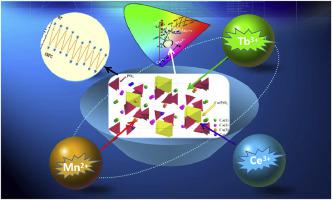当前位置:
X-MOL 学术
›
J. Rare Earths
›
论文详情
Our official English website, www.x-mol.net, welcomes your feedback! (Note: you will need to create a separate account there.)
Tunable emission properties of tri-doped Ca9LiY2/3(PO4)7:Ce3+, Tb3+, Mn2+ phosphors with warm white emitting based on energy transfer
Journal of Rare Earths ( IF 4.9 ) Pub Date : 2020-05-01 , DOI: 10.1016/j.jre.2020.05.001 Jindi Wang , Riyan Su , Min Cui , Mengmeng Shang
Journal of Rare Earths ( IF 4.9 ) Pub Date : 2020-05-01 , DOI: 10.1016/j.jre.2020.05.001 Jindi Wang , Riyan Su , Min Cui , Mengmeng Shang

|
Abstract Tri-doped Ca9LiY2/3(PO4)7:Ce3+,Tb3+,Mn2+ phosphors were prepared by a high-temperature solid state method. Under UV light excitation, Ca9LiY2/3(PO4)7:Ce3+ samples exhibit a broad band ranging from 320 to 500 nm. At 77 K, the emission spectra of Ca9LiY2/3(PO4)7:Ce3+ samples present two obvious emission peaks, indicating that Ce3+ ions occupy two different kinds of lattice sites (Ca(1/2) and Ca(3)). As a good sensitizer for Tb3+, Ce3+ ions in Ca9LiY2/3(PO4)7 lattice can effectively transfer part of energy to Tb3+, and the energy transfer mechanism is determined to be dipole-dipole interaction. Consequently, the emitting color for Ce3+ and Tb3+ co-doped Ca9LiY2/3(PO4)7 samples can be tuned from bluish violet to green. In order to further enlarge the emission gamut, Mn2+ ions as red emission components were added, forming tri-doped single-phase Ca9LiY2/3(PO4)7:Ce3+,Tb3+,Mn2+ phosphors. The Ca9LiY2/3(PO4)7:Ce3+,Tb3+,Mn2+ phosphors exhibit tunable emission properties through controlling the relative doping concentration of Ce3+, Tb3+ and Mn2+. Especially, Ca9LiY2/3(PO4)7:0.09Ce3+,0.12 Tb3+, 0.30Mn2+ can emit warm white light. The sample shows good thermal stability. At 150 °C, the emission intensity for Ce3+ (360 nm), Tb3+ (545 nm) and Mn2+ (655 nm) decreases to 63%, 69%, and 72% of its initial intensity, respectively. Moreover, the sample obtains good stability after 10 cycles between room temperature and 150 °C.
中文翻译:

基于能量转移的暖白光三掺杂 Ca9LiY2/3(PO4)7:Ce3+、Tb3+、Mn2+ 荧光粉的可调发射特性
摘要 采用高温固相法制备了三掺杂Ca9LiY2/3(PO4)7:Ce3+,Tb3+,Mn2+荧光粉。在紫外光激发下,Ca9LiY2/3(PO4)7:Ce3+ 样品表现出 320 到 500 nm 的宽谱带。在 77 K 时,Ca9LiY2/3(PO4)7:Ce3+ 样品的发射光谱呈现两个明显的发射峰,表明 Ce3+ 离子占据两种不同的晶格位点(Ca(1/2) 和 Ca(3))。作为Tb3+的良好敏化剂,Ca9LiY2/3(PO4)7晶格中的Ce3+离子可以有效地将部分能量转移给Tb3+,能量转移机制被确定为偶极-偶极相互作用。因此,Ce3+ 和 Tb3+ 共掺杂 Ca9LiY2/3(PO4)7 样品的发光颜色可以从蓝紫色调到绿色。为了进一步扩大发射色域,加入了Mn2+离子作为红色发射成分,形成三掺杂单相 Ca9LiY2/3(PO4)7:Ce3+,Tb3+,Mn2+ 荧光粉。Ca9LiY2/3(PO4)7:Ce3+,Tb3+,Mn2+ 荧光粉通过控制 Ce3+、Tb3+ 和 Mn2+ 的相对掺杂浓度表现出可调发射特性。特别是Ca9LiY2/3(PO4)7:0.09Ce3+,0.12Tb3+,0.30Mn2+能发出暖白光。样品显示出良好的热稳定性。在 150 °C 时,Ce3+ (360 nm)、Tb3+ (545 nm) 和 Mn2+ (655 nm) 的发射强度分别降低至其初始强度的 63%、69% 和 72%。此外,样品在室温和 150°C 之间循环 10 次后获得了良好的稳定性。0.30Mn2+可发出暖白光。样品显示出良好的热稳定性。在 150 °C 时,Ce3+ (360 nm)、Tb3+ (545 nm) 和 Mn2+ (655 nm) 的发射强度分别降低至其初始强度的 63%、69% 和 72%。此外,样品在室温和 150°C 之间循环 10 次后获得了良好的稳定性。0.30Mn2+可发出暖白光。样品显示出良好的热稳定性。在 150 °C 时,Ce3+ (360 nm)、Tb3+ (545 nm) 和 Mn2+ (655 nm) 的发射强度分别降低至其初始强度的 63%、69% 和 72%。此外,样品在室温和 150°C 之间循环 10 次后获得了良好的稳定性。
更新日期:2020-05-01
中文翻译:

基于能量转移的暖白光三掺杂 Ca9LiY2/3(PO4)7:Ce3+、Tb3+、Mn2+ 荧光粉的可调发射特性
摘要 采用高温固相法制备了三掺杂Ca9LiY2/3(PO4)7:Ce3+,Tb3+,Mn2+荧光粉。在紫外光激发下,Ca9LiY2/3(PO4)7:Ce3+ 样品表现出 320 到 500 nm 的宽谱带。在 77 K 时,Ca9LiY2/3(PO4)7:Ce3+ 样品的发射光谱呈现两个明显的发射峰,表明 Ce3+ 离子占据两种不同的晶格位点(Ca(1/2) 和 Ca(3))。作为Tb3+的良好敏化剂,Ca9LiY2/3(PO4)7晶格中的Ce3+离子可以有效地将部分能量转移给Tb3+,能量转移机制被确定为偶极-偶极相互作用。因此,Ce3+ 和 Tb3+ 共掺杂 Ca9LiY2/3(PO4)7 样品的发光颜色可以从蓝紫色调到绿色。为了进一步扩大发射色域,加入了Mn2+离子作为红色发射成分,形成三掺杂单相 Ca9LiY2/3(PO4)7:Ce3+,Tb3+,Mn2+ 荧光粉。Ca9LiY2/3(PO4)7:Ce3+,Tb3+,Mn2+ 荧光粉通过控制 Ce3+、Tb3+ 和 Mn2+ 的相对掺杂浓度表现出可调发射特性。特别是Ca9LiY2/3(PO4)7:0.09Ce3+,0.12Tb3+,0.30Mn2+能发出暖白光。样品显示出良好的热稳定性。在 150 °C 时,Ce3+ (360 nm)、Tb3+ (545 nm) 和 Mn2+ (655 nm) 的发射强度分别降低至其初始强度的 63%、69% 和 72%。此外,样品在室温和 150°C 之间循环 10 次后获得了良好的稳定性。0.30Mn2+可发出暖白光。样品显示出良好的热稳定性。在 150 °C 时,Ce3+ (360 nm)、Tb3+ (545 nm) 和 Mn2+ (655 nm) 的发射强度分别降低至其初始强度的 63%、69% 和 72%。此外,样品在室温和 150°C 之间循环 10 次后获得了良好的稳定性。0.30Mn2+可发出暖白光。样品显示出良好的热稳定性。在 150 °C 时,Ce3+ (360 nm)、Tb3+ (545 nm) 和 Mn2+ (655 nm) 的发射强度分别降低至其初始强度的 63%、69% 和 72%。此外,样品在室温和 150°C 之间循环 10 次后获得了良好的稳定性。


























 京公网安备 11010802027423号
京公网安备 11010802027423号